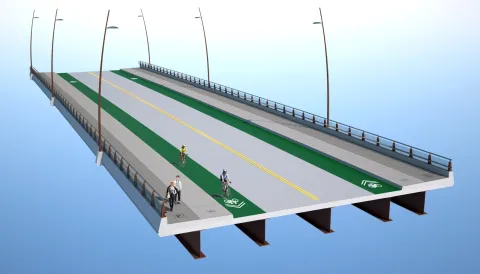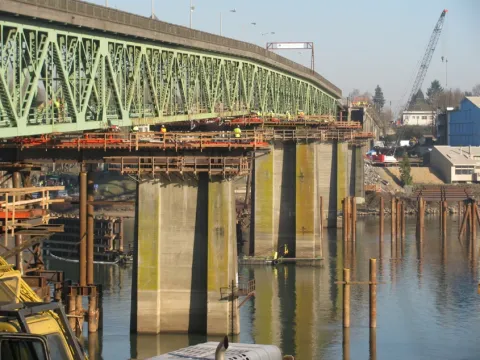Oregon's first registered Greenroads project

The Sellwood Bridge is the first registered project in Oregon to pursue Greenroads certification. Greenroads is an independent certification process for sustainable transportation projects similar to the LEED program for buildings.
Greenroads certification:
- Applies to new and reconstructed roads and bridges
- Recognizes and quantifies road and bridge sustainable practices
- Awards points for pre-defined and project specific, innovative sustainable practices
Taking sustainability to the next level
For a project to achieve Greenroads certification, it must go above and beyond the minimum environmental requirements. Choices made on the design, its integration with the surrounding environment and community, and the construction materials selected all affect the environmental impact of a bridge or road, and provide opportunities for sustainability
A Greenroad:
- Efficiently uses resources and renewable materials
- Considers the lifecycle costs of a project
- Helps reduce emissions
- Manages waste
- Designed to be accessible to all
Sustainable design and construction practices accumulate points that lead to one of four levels of Greenroads certification. Categories for points include:
- Access and equity
- Construction activities
- Environment and water
- Materials and resources
- Pavement technology
Sustainability and the Sellwood Bridge
The Sellwood Bridge is one of the largest projects in the country to pursue Greenroads certification. Its sustainable features include multi-modal design, waste reduction during construction, and re-using the existing span as a detour bridge to reduce environmental impacts. This Multnomah County project is on track to achieve one of the four Greenroads levels, but final assessment will not take place until later in the project.
Multi-modal design

shared-use sidewalks, two six and a half foot bike lanes/shoulders, and two 12’ traffic lanes that can accommodate TriMet buses or a future streetcar line.
Reducing waste
Active reuse and recycling practices for demolished features have resulted in significantly less material sent to the landfill. Consider:
- Construction waste to date: 3174 tons
- Recycled material to date: 2906 tons
- Trash to date: 268 tons
Over 91% of overall waste materials have been recycled. Recycled materials have included materials from buildings removed on each side of the river (over 94% of their waste was recycled). Cedar trees that were removed on the west side of the river were donated to local tribes to be made into traditional garments and ceremonial items.
What’s gained in translation

A big project without a big footprint
The final design footprint was reduced significantly from early concepts, reducing the overall cost, materials required, and environmental disturbances, like stormwater runoff and aquatic and riparian impacts.
Context-sensitive design
The new steel deck arch span received community support and fits well with the scale and context of its surroundings. The bridge includes recycled steel and arches made of weathering steel that will never need to be painted.
